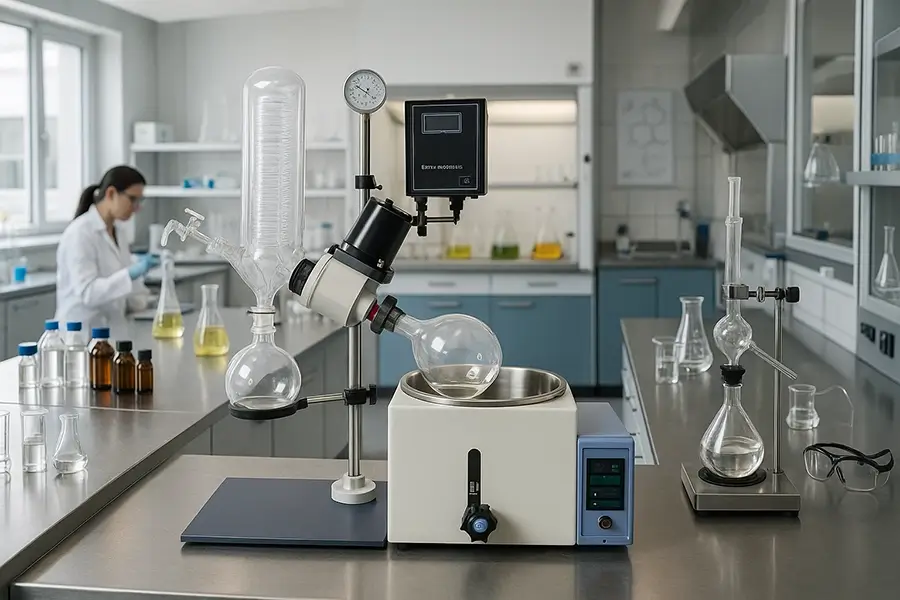How Can Rotary Evaporators Revolutionize Your Flavor and Fragrance Extraction Process?
Struggling with inefficient extraction methods that damage delicate aromas? Are you losing valuable product and time? This common frustration can hinder your ability to produce high-quality flavors and fragrances.
Rotary evaporators offer a gentle, efficient solution for concentrating flavors and fragrances. They work by reducing pressure to lower the solvent's boiling point, allowing for rapid evaporation without excessive heat. This preserves the delicate aromatic compounds, resulting in a purer, more potent final product.
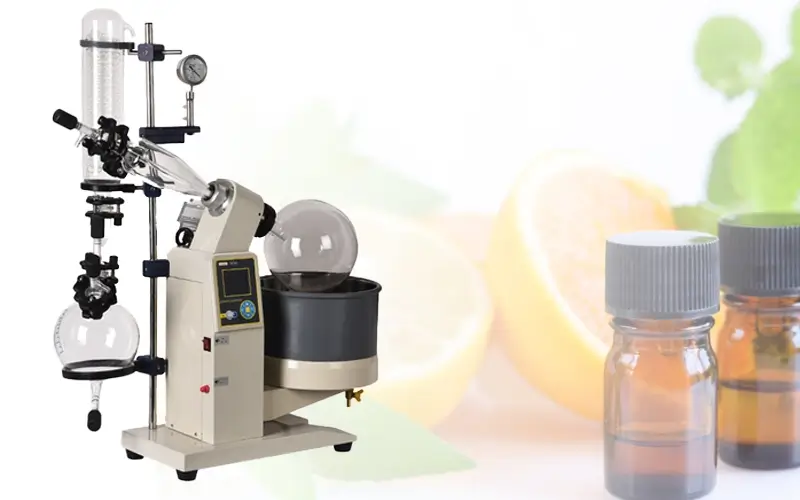
As a manufacturer with over 16 years of experience in laboratory equipment, I've seen firsthand how the right tools can transform an operation. We've helped countless businesses, from artisanal producers to large-scale facilities, refine their extraction techniques. The journey to perfect extraction can seem complex, but understanding the core principles of your equipment is the first step. This is especially true for rotary evaporators, which are workhorses in modern labs. They give you control and precision. Let's explore how they can specifically benefit your work in the flavor and fragrance industry.
What Makes Rotary Evaporators So Effective for Extracting Delicate Aromas?
Are you worried about high temperatures degrading the subtle notes in your extracts? Traditional heating can destroy the very essence you're trying to capture. This is a big problem for quality.
Rotary evaporators excel by using vacuum to lower the solvent's boiling point. This means evaporation occurs at much lower temperatures, protecting heat-sensitive aromatic compounds. The rotation also ensures even heat distribution and prevents localized overheating, preserving the integrity of the extract.

When we talk about delicate aromas, we're referring to volatile organic compounds (VOCs) that give flavors and fragrances their unique character. These compounds are often very sensitive to heat. If you apply too much heat during extraction or concentration, these VOCs can degrade, change, or simply evaporate away completely, leading to a flat or off-note product. I remember a client who was trying to extract a specific floral note; their old methods were "cooking" the essence out. When they switched to one of our rotary evaporators, the difference was night and day.
Key Principles at Play:
Vacuum Application: This is the heart of the rotary evaporator's gentle nature. By reducing the ambient pressure within the system, we significantly lower the temperature at which your chosen solvent will boil. For example, ethanol might boil at 78°C at atmospheric pressure, but under a vacuum, it can boil at room temperature or even lower.
Rotating Flask: The rotation serves multiple purposes. It continuously spreads the sample into a thin film on the inner surface of the flask. This increases the surface area for evaporation, making the process much faster and more efficient. It also ensures that the heat from the water bath is distributed evenly, preventing hot spots that could damage your precious extract.
Controlled Heating: The water or oil bath provides precise and stable temperature control. You can set it just right to encourage evaporation without "shocking" the delicate compounds.
This combination means you are removing the solvent under the mildest possible conditions. We've designed our rotary evaporators with precise control systems because we know how critical temperature and vacuum stability are for high-quality results in the flavor and fragrance industry. It’s about preserving that true essence.
Which Solvents Work Best with Rotary Evaporators for Flavor and Fragrance Extraction?
Choosing the wrong solvent can lead to poor yields or even contaminate your final product. Are you unsure which solvents are compatible and efficient for your Laboratory Rotary Evaporator setup?
Commonly, low-boiling point solvents like ethanol, methanol, hexane, and ethyl acetate are ideal for rotary evaporation in flavor and fragrance extraction. The key is to select a solvent that effectively dissolves your target compounds and can be easily removed under vacuum without leaving residues.
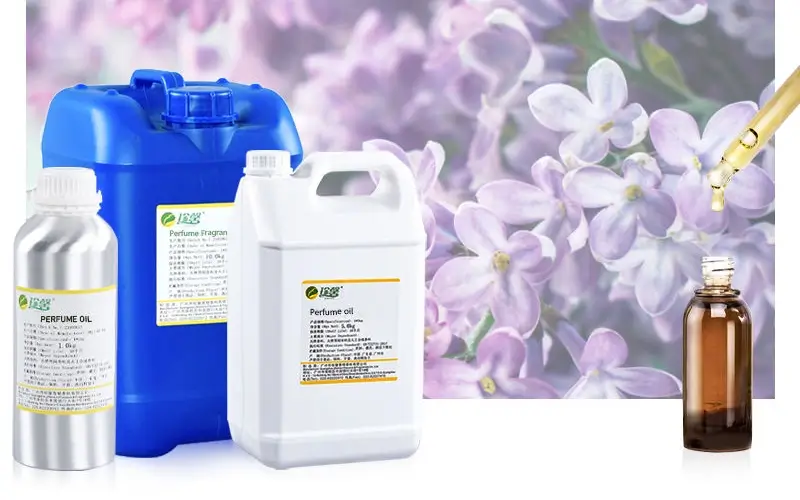
The choice of solvent is absolutely critical in any extraction process, and this is no different when using a rotary evaporator for concentration. Your goal is to find a solvent that is a good match for the compounds you want to extract and also for the rotary evaporation process itself. As manufacturers, we often get asked about solvent compatibility with the seals and glassware of our units. All our standard rotary evaporators are built with high-quality borosilicate glass and PTFE seals, which are resistant to a wide range of common solvents. Here’s a bit more to consider:
Factors for Solvent Selection:
Solubility: The solvent must effectively dissolve the desired flavor or fragrance compounds from your raw material. Different compounds have different polarities, so you'll need to match your solvent accordingly. For instance, ethanol is great for a wide range of plant-based compounds.
Boiling Point: Lower boiling points are generally preferred because they evaporate more easily under vacuum at lower temperatures. This speeds up the process and is gentler on the extract. However, it shouldn't be so low that you lose solvent prematurely.
Purity and Reactivity: The solvent should be of high purity to avoid introducing contaminants into your extract. It also must not react with your target compounds.
Safety: Consider the flammability and toxicity of the solvent. Always work in a well-ventilated area, preferably a fume hood, especially with volatile organic solvents.
Cost and Availability: For larger-scale operations, the cost and ease of sourcing the solvent can be important factors.
Common Solvents and Their Uses:
| Solvent | Typical Use Cases in Flavor/Fragrance | Notes for Rotary Evaporation |
|---|---|---|
| Ethanol | Herbal extracts, tinctures, many essential oils | Relatively safe, effective, easy to evaporate. Good for food-grade applications. |
| Hexane | Lipophilic compounds, some essential oils, oleoresins | Efficient for non-polar compounds. Requires good ventilation due to flammability. |
| Ethyl Acetate | Fruit essences, certain aroma compounds | Lower boiling point than ethanol, good for delicate aromas. |
| Methanol | Analytical purposes, some specific extractions | More toxic than ethanol; use with caution and excellent ventilation. |
I always tell my clients to do small test batches if they are unsure about a solvent. It's better to confirm compatibility and efficiency on a small scale before committing a large amount of valuable raw material. Our team, with its extensive experience, can also provide guidance on suitable solvents for various applications based on the equipment we provide.
How Can I Optimize My Rotary Evaporator Setup for Maximum Flavor Yield?
Are you getting less extract than you expected? Optimizing your setup can be tricky, with many variables affecting efficiency. You might be losing valuable product without realizing it.
To maximize yield, ensure a proper vacuum level, set an optimal bath temperature (usually 20-30°C above the solvent's boiling point under vacuum), control the rotation speed for an even film, and avoid overfilling the evaporating flask (typically half-full is best).
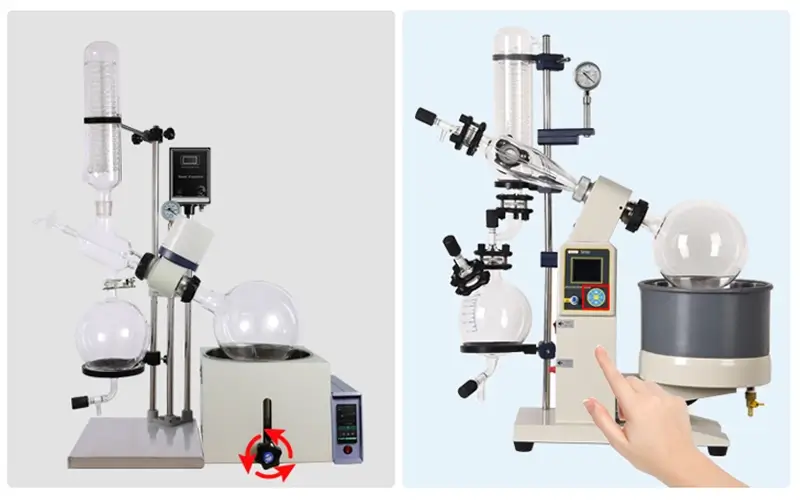
Getting the most out of your rotary evaporator isn't just about having good equipment; it's about using it smartly. Over my years in this business, I've seen how small adjustments can lead to big improvements in yield and quality. It's a bit like tuning an instrument – every part needs to work in harmony. Here are some specific areas I always advise our customers to focus on:
Key Optimization Parameters:
Vacuum Level: This is probably the most critical setting. You need a vacuum pump that can achieve and maintain the appropriate pressure for your solvent. Too little vacuum, and the solvent won't evaporate efficiently at low temperatures. Too much vacuum, and you might cause bumping or lose volatile product components into the vacuum pump if your cold trap isn't efficient enough. We often provide vacuum controllers with our systems for this reason.
Bath Temperature: The general rule is to set the bath temperature about 20-30°C higher than the boiling point of your solvent *at the operating vacuum*. If the bath is too cold, evaporation will be slow. If it's too hot, you risk degrading your sample or causing bumping.
Rotation Speed: The ideal speed creates a thin, even film of your sample on the flask's inner surface. This maximizes the surface area for evaporation. If it's too slow, the film might not be even. If it's too fast, you might create too much turbulence. Typically, speeds between 100-180 RPM are a good starting point for many of our units, but this can vary.
Flask Fill Volume: Never fill the evaporating flask more than halfway. Overfilling reduces the surface area for evaporation and dramatically increases the risk of "bumping," where the solution violently boils over into the collection flask or even the condenser. This is a common mistake I see beginners make.
Condenser Coolant Temperature: Ensure your condenser is adequately cooled. The coolant (usually tap water or a recirculating chiller) needs to be cold enough to efficiently condense the solvent vapors. If the condenser is too warm, solvent vapors will pass through and be lost to the vacuum pump, reducing recovery and potentially damaging the pump. We often recommend our chillers for precise temperature control.
System Integrity: Check for leaks! Any air leaks in your system will reduce vacuum efficiency and slow down evaporation. Regularly inspect glassware joints, seals, and tubing.
I like to tell a story about a small essential oil producer who was struggling with low yields. We went through their process, and it turned out their vacuum pump wasn't quite right for the scale of their rotary evaporator, and they weren't using a cold trap effectively. After a few adjustments and adding one of our compatible pumps and a better cold trap, their yields increased by nearly 30%. It’s often these details that make all the difference.
Are Rotary Evaporators Suitable for Both Small-Scale Artisanal and Large-Scale Commercial Production?
Wondering if a rotary evaporator fits your production scale? Whether you're a boutique creator or a large company, finding scalable solutions is key. Can this technology adapt to your needs?
Yes, rotary evaporators are highly versatile. They come in various sizes, from small benchtop models (1L to 5L) ideal for R&D and artisanal production, to larger industrial-scale units (10L, 20L, 50L, even 100L) designed for commercial output, ensuring scalability.
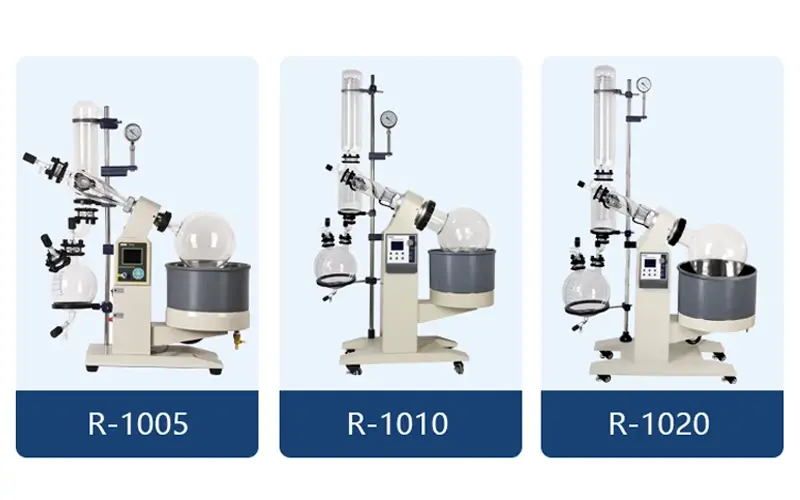
One of the things I appreciate most about rotary evaporator technology is its incredible scalability. As a company that has been exporting these instruments for over 16 years, we've supplied everyone from university research labs and small start-up distilleries to large pharmaceutical and food processing plants. The fundamental principle of operation remains the same, but the engineering adapts to the volume and throughput requirements.
Scaling Up Considerations:
Flask Size: This is the most obvious difference. Our lab-scale models typically range from 1L to 5L evaporating flasks. For pilot plants or larger production, we offer units with 10L, 20L, 50L, and even 100L flasks. We’ve worked on custom solutions beyond that too.
Condenser Capacity: Larger evaporating flasks mean more solvent needs to be condensed. Industrial rotary evaporators have much larger, more efficient condenser systems, often with dual condensers, to handle the increased vapor load.
Heating Bath Power and Volume: A 50L flask needs a significantly more powerful and larger heating bath than a 1L flask. These baths also need robust temperature control to maintain stability with larger liquid volumes.
Vacuum Pump Capacity: The vacuum pump must be sized appropriately to evacuate the larger system volume quickly and maintain the desired vacuum level against a higher solvent evaporation rate.
Automation and Controls: Larger units often come with more advanced control systems. This can include programmable evaporation profiles, integrated vacuum control, automatic bath lifting, and safety features suitable for industrial environments. Some of our larger models feature explosion-proof designs for use with flammable solvents.
Material Handling: Dealing with a 50L flask full of solvent is very different from a 1L flask. Industrial units incorporate features like motorized lifts for the heating bath and flask, and sometimes systems for easier draining and filling.
I recall a customer who started with one of our 5L rotary evaporators for developing new botanical extracts. As their business grew, they were so pleased with the performance and reliability that they came back to us for a 20L unit, and then later a 50L unit. It was a smooth transition for them because the operating principles they learned on the smaller unit were directly applicable to the larger ones. This is a key advantage – the process knowledge scales with the equipment. We ensure our larger units maintain the same precision and care for the product as our lab-scale ones, which is crucial for flavors and fragrances where consistency is king.
What Key Features Should I Look For When Buying a Rotary Evaporator for My Lab?
Feeling overwhelmed by the options when choosing a rotary evaporator? Selecting the right features is crucial for performance, safety, and longevity. Don't want to make a costly mistake?
Look for precise temperature and rotation control, a high-quality vacuum seal for efficiency, durable borosilicate glassware, adequate condenser size, safety features like over-temperature protection and bath lift, and good after-sales support from the manufacturer. Consider ease of use and cleaning too.
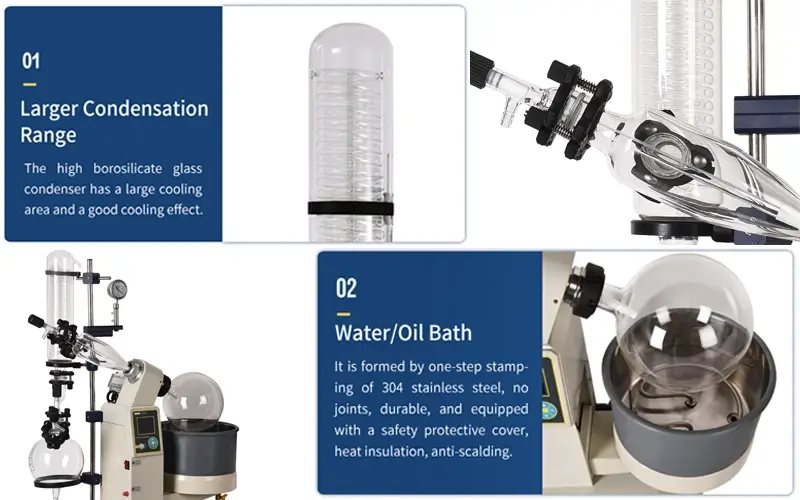
Choosing the right rotary evaporator is an important investment for any lab involved in flavor and fragrance extraction. After so many years in this industry, I've seen what makes a difference in day-to-day operations. It's not just about the basic function; it's about reliability, ease of use, and safety. We've incorporated many features into our ZZKD models based on direct customer feedback and our R&D efforts.
Essential Features Checklist:
Digital Controls for Temperature, Speed, and Vacuum: Precision is key. Digital displays and controls allow for accurate and repeatable settings. Integrated vacuum control is a huge plus.
Quality of Glassware: Ensure it's made from high-quality borosilicate glass 3.3, which offers excellent chemical resistance and thermal shock durability. The design of the evaporation flask and condenser also matters for efficiency.
Sealing System: A robust and durable sealing system (often PTFE) is vital to maintain a deep vacuum and prevent leaks. This directly impacts evaporation efficiency and solvent recovery.
Safety Features:
Motorized Lift: Allows for easy and safe lifting of the flask from the heating bath, especially important in case of power failure or overheating. Manual lifts are common on basic models, but motorized is preferred for convenience and safety on larger units.
Over-Temperature Protection: Prevents the heating bath from exceeding a set temperature.
Dry-Run Protection: Protects the heating bath if it runs without water/oil.
Safety Coated Glassware (Optional): Provides an extra layer of protection against breakage and spillage.
Condenser Design and Size: The condenser should be appropriately sized for the evaporation flask and have an efficient design (e.g., coil or cold finger) to ensure complete condensation of solvent vapors. Consider units with options for vertical or diagonal condensers depending on your space and preference.
Ease of Use and Maintenance: Are the controls intuitive? Is it easy to attach and detach flasks? How simple is it to clean the components? These factors impact daily workflow.
Modularity and Accessories: Can the system be expanded with different glassware, vacuum pumps, or chillers from the same supplier? We pride ourselves on offering comprehensive solutions.
Manufacturer Support and Warranty: This is crucial. As a company that provides 24/7 after-sales support, we understand its importance. Look for a reliable warranty, availability of spare parts, and accessible technical support. Having over 50% English-speaking engineers, we ensure seamless communication for our international clients.
I always advise potential buyers to think about their specific applications. What solvents will you use? What batch sizes? What level of automation do you need? For instance, if you're working with very heat-sensitive compounds, precise vacuum control and a gentle lift mechanism become even more critical. We established our 24/7 after-sales support precisely because we know that our customers rely on our equipment for their critical processes, and downtime is not an option. Investing in a unit with the right features from a reputable manufacturer with good support will pay off in the long run through reliable performance and peace of mind.
Conclusion
Rotary evaporators are invaluable for quality flavor and fragrance extraction, offering gentle, efficient concentration. Choosing the right model and optimizing its use will significantly enhance your product's purity and yield.

E-mail:
WhatsApp:
Address:
19/F, Block B, Guohong Mansion, Hi-Tech Development Zone, Zhengzhou City, Henan Province, China
Related blogs
You May also like
How Rotovap Machines Revolutionize Acetonitrile Recovery
Discover how rotary evaporators revolutionize acetonitrile recovery. Learn cost-saving techniques, equipment selection tips & proven ROI strategies. Essential...
Read MoreWhat Makes a Rotary Evaporator Essential for High-Purity Ethanol Extraction?
A rotary evaporator is essential for ethanol extraction because it uses vacuum pressure to lower the solvent's boiling point. This allows for gentle, rapid, a...
Read More

